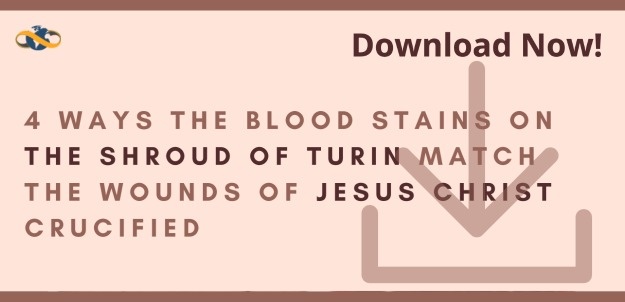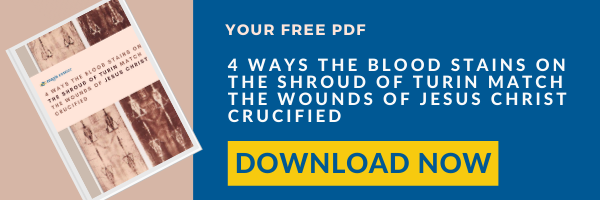The Shroud of Turin is a linen burial shroud that is believed to have covered a man who suffered the wounds of crucifixion in a very similar way to Jesus of Nazareth. One reason for this belief is the blood evidence on the Shroud.

Studies have shown that this image on the Shroud was not produced by any paint, dye, powder, or other artistic chemical or biological agent and has no brush strokes.
Instead, there are traces of hemoglobin, AB+ blood type, and a partial genetic profile. The evidence from the Shroud of Turin blood stains points to its authenticity as a burial shroud, but is it the shroud of Jesus?
The placement of the blood sheds some light on this mystery.
The anatomically perfect image on the shroud was formed after the blood stains congealed on the cloth, and the image and blood stains, relative to one another, not only reflect the wounds of crucifixion, but the wounds of Jesus specifically.
Furthermore, Jesus’ crucifixion was not one common to Roman criminals. There are five distinctions that differentiate Jesus’ crucifixion from others of his time.
- Crown of thorns - Jesus is wearing crown of thorns on account of him being mocked as the king of the Jews. Other criminals would not have been crucified with a crown of thorns.
- Wound in his side - The Romans did not typically put people out of their misery, but they wanted to insure the death of Jesus. The spear pierced the pericardial sac, which first releases a transparent fluid looking like water and then a flow of blood.
- Nails in his wrists - It was the Roman custom to configure the victim to the cross by ropes and not nails. Although most depictions of Christ crucified show the nails going through the hands, they would not have held Jesus to the cross on account of their fleshy tissue. Thus, the Roman soldier nailed Jesus to the cross through the wrist and up through the hand where there is a multitude of nerve fibers which would cause extreme pain.
- Nails piercing his feet - Again, this was not the custom at the time. These nails also touched a series of nerve fibers, so that every time Jesus lifted himself up to breathe the pain would have been excruciating.
- The presence of ferritin and other enzymes - Ferritin is produced in blood only under immense stress and thus show that the man whose blood is on the shroud was severely tormented and tortured.
The confluence between the Shroud and the Gospels is so close, it is difficult to imagine how it could be anyone other than Jesus.
But there is still more scientific evidence to be had for the Shroud, as explained in Fr. Spitzer’s full article on the Shroud.
The church has yet to claim the authenticity of the shroud, but many popes have venerated it in its home at the Cathedral of Turin.
I will leave you with a quote from John Paul II’s address on the Shroud.
“Before the Shroud, the intense and agonizing image of an unspeakable torment, I wish to thank the Lord for this unique gift, which asks for the believer's loving attention and complete willingness to follow the Lord.”

